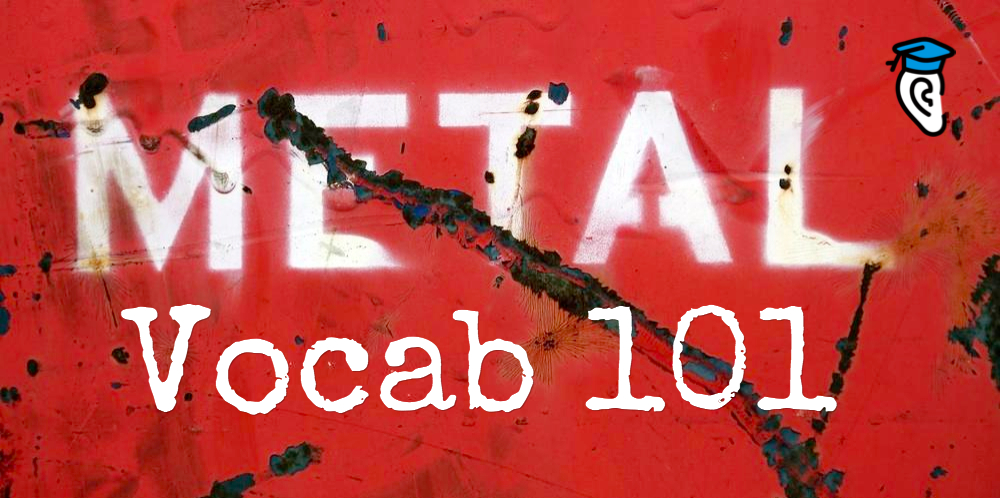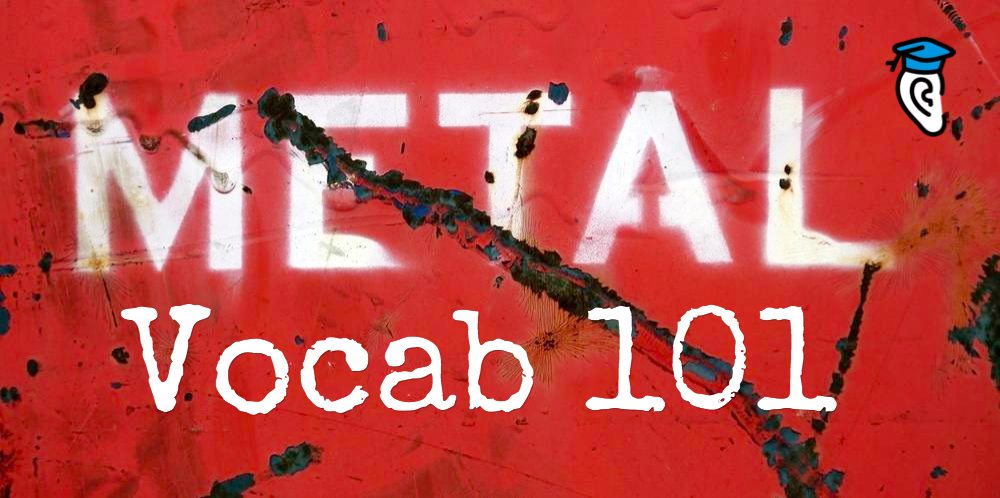The term “heavy metal” or simply “metal” very often tends to conjure up images of hairy overweight bikers rocking out to Metallica. Another common misconception is that all metal music is incomprehensible angry music, screaming satanic lyrics. In fact metal is a very wide and complex style of music, encompassing any and every type of musical technique.
Like most genres of music, metal has its own vocabulary and terminology which can seem off-putting to beginners. Let’s clear that up! Here are just a few popular musical terms used in Metal music.

Metal Guitar Vocab
Standard/Drop tunings
Depending on how heavy a specific band wants to be, guitars are tuned accordingly. Standard Tunings like “D Standard” or “B Standard” involve tuning guitars down (or sometimes up) completely, with the name corresponding to the bottom string. So if a guitar was in D Standard, each string would be a whole step lower than E Standard (the normal tuning for guitars).
Drop Tunings like “Drop D” or “Drop B” are where the lowest string is retuned. This can either imply retuning everything and retuning the bottom string lower than normal or it can mean retuning the bottom string only. So if a guitar was in Drop C, the strings could go C, G, C, F, A, D (retuning to D Standard and then dropping the bottom string to C) or C, A, D, G, B, E (only the bottom string is different from the normal E Standard tuning).
Power Chords
Power chords are a standard way of playing the guitar in metal, based around simplified chords. Usually the rhythm guitarist plays power chords. These chords consist of the root of the chord plus the fifth of the chord, removing the normal “third” note in between. This means the chord is neither major nor minor and has a simple strong sound.
Normally these are played either as the root, a perfect fifth above, and root note again above that, or as a combination of the root note and a perfect fourth below. This makes the overall sound much fuller. For example if someone was playing an E♭ power chord they might play E♭, the B♭ above it, and the E♭ above that. Or they might simply play E♭ and the B♭ below it.
Sweep-Picking
This is a guitar technique often seen as flashy or “showing off” which involves very fast guitar melodies, usually during a guitar solo, while “sweeping” the right hand up and down the strings in a very smooth fashion with the pick. Sweep-picking is a very difficult technique to master.
Metal Singing Vocab
Harsh Vocals
Harsh vocals is a term to mean anything that is not “sung”, aka “clean vocals”. There are lots of different ways to perform harsh vocals, including Death/Black metal vocals, Screamo, pig squeals and many others. If you learn how to vocalise these techniques properly, you should not wreck your voice. Here is an example of a Death metal grunt followed by a Black metal scream:
Cupping the mic
This is a term used when vocalists cup their hand(s) around the windscreen of the microphone. While this may look cool, it is actually a very bad mic technique and makes the overall sound you’re producing very tinny! This is due to your hand covering up the sides and the rear of the windscreen, which is also taking in sound waves. It does not “focus the sound” as many would have you believe.
Metal Percussion Vocab
Double Kick
In metal, the bass pedal is in fact called the kick pedal, and a separate drum placed next to the toms is called the bass drum. Metal utilises the “double kick”, where the drummer will use two pedals and both feet to create a fast, powerful rhythm in the bass.
Blast Beats
Something distinguishable about metal is blast beats, which is a type of drum part involving very fast double kick with on-beat high hat or ride with off-beat snare. It is often used in heavier genres of metal including Death and Black metal, but it is by no means restricted to those two.
General Metal Vocab
Sub-genres
There are several main genres in metal, but there are a large number of sub-genres in metal too. These often fuse two genres together, or take a style of music from outside metal and combining it with metal. Some examples of sub-genres include Symphonic Black Metal, Mathcore and Humppa Metal.
Djent
Djent is a style of metal that emphasises complexity. Rhythms and time signatures in particular are very complicated, and guitarists often use instruments with extra strings to create a bigger pitch range and a much lower tuning, making the music sound heavier.
Breakdown
Generally a breakdown means a section of a song where most of the instruments stop playing to showcase just one or two, often focusing on the rhythm section. In metal it normally a point in a song where the speed instantly slows down to half, sometimes a quarter of the normal or original speed. This is determined by the drums, however the guitars often do intricate and fast rhythms while a breakdown occurs.
Head-banging
Finally, head-banging! Often deemed fascinating by those not familiar with metal, as it involves vigorously throwing your (preferably long) hair around as if you were waving a flag. Why do musicians do it? It is very much like being in a trance and can get you more into the music you are playing. It can however be very dangerous, particularly in a crowd at a concert, so you should learn to do it properly and not perform it excessively!
These are the main vocabulary terms used in metal music. If you’re just starting to explore this awesome genre I hope that’s cleared up some things for you! Have I missed any important ones, or is there something you can’t figure out the meaning of? Post a comment and let me know.







